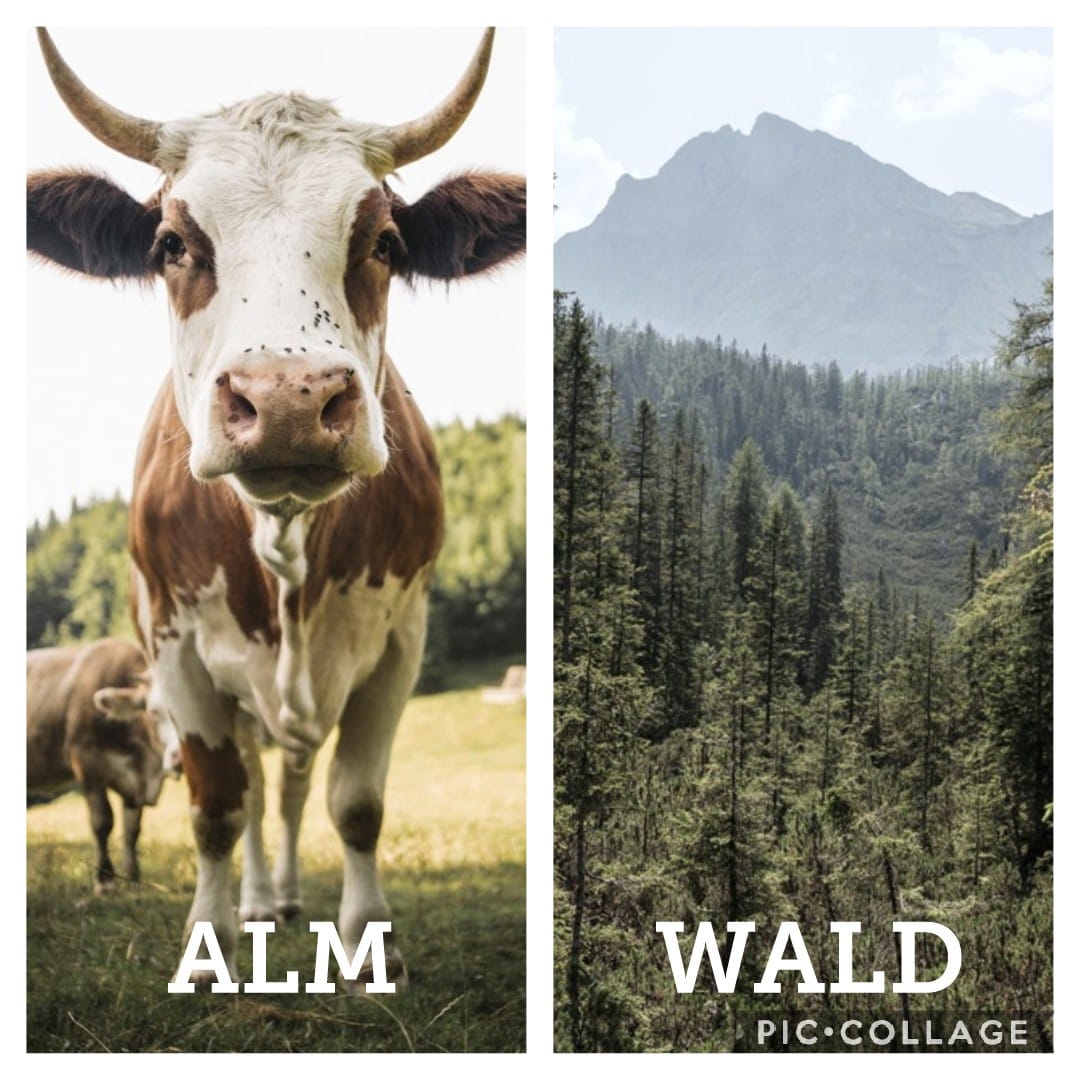Alpine meadow & forrest
Cultural landscapes of the Styrian Eisenwurzen
The Styrian Eisenwurzen Nature Park has existed since 1996 and, at 58,600 hectares, is the largest nature park in Styria. It is home to spectacular natural spectacles, unique landscapes and rare animal and plant species, some of which are under special protection through additional categories. The legal aim of the nature parks is to protect a landscape in connection with its use. Particularly valuable, formative cultural landscape areas are to be protected from destruction and developed. The region is characterized by three cultural landscapes: managed forests, water bodies of the Enns and Salza, and grassland.
The present project now focuses on the two cultural landscapes Alm and Forest and comprises a total of 3 goals:
Objective 1: Focus on the Alm cultural landscape
- Work package 1.1. Survey of the nature conservation and alpine farming condition of the alpine pastures in the Nature and Geopark
- Work package 1.2. Establishment of two flagship pastures
- Work package 1.3. Networking of alpine farmers in the Steirische Eisenwurzen Nature and Geopark
- Work package 1.4. Raising awareness for Alm visitors
Goal 2: Focus on the cultural landscape of forests
- Work package 2.1 Public relations and education
- Work package 2.2. Role of the Nature and Geopark
- Work package 2.3. Nature park forest management
- Work package 2.4. Evaluation of stepping stone biotopes
Objective 3: project-related public relations work
Our alpine pastures – sensitive beauties
There are over 70 alpine pastures in the Styrian Eisenwurzen Nature and Geopark. They feed the grazing cattle in summer, are home to many rare, wild plants and animals and beautify the landscape. But the pastures are in danger. It is becoming increasingly difficult for farmers to make a living from agriculture and more and more are giving up their farms. When the grazing cattle are no longer driven to the alpine pastures, the pastures grow over and the alpine pastures disappear.
The alpine pastures in the Styrian Eisenwurzen Nature and Geopark are very special habitats. Compared to other mountain areas, they are quite low – often only 1000 meters above sea level. Most of the time they are willow islands in the middle of the forest. Or they are even made up of forest themselves and are then referred to as forest pastures.
Have you noticed our awareness-raising material for Alm visitors? In many businesses in the nature park region, posters, beer mats, table displays and brochures now provide information about the topic of alpine pastures, in our alpine pasture film we present the project and our flagship alpine pastures, it’s worth taking a look!
Colorful alpine dwellers
Many different types of flowers grow on the meager alpine pastures. A well-known representative is arnica. It grows mainly on so-called mat grass lawns. Not all pasture is the same. Depending on how many and which nutrients are in the soil and how the area is cultivated, very special plants grow together on a pasture. In a mat grass lawn, for example, gentian, bearded bellflower or tormentil are often found together with arnica.
Arnica is a medicinal plant that has been known for a long time. This is reflected in their different trivial names: It is also called Bergwohlleih, Engelkraut or Kraftwurz. The plant is mostly used for different types of inflammation of the muscles, joints or skin. It is applied externally as a tincture or ointment.
Drawing: Geert Gratama
A strong family
On the alpine pastures in the Styrian Eisenwurzen Nature and Geopark you will usually find two different types of cattle herds: herds of young cattle or herds of suckler cows.
In a mother cow herd there are cows with their calves, sometimes there is also a bull. The calves still drink milk from their mothers. Usually each cow has one calf, rarely two. Suckler cow herds have a distinctive social behavior. There is a close relationship between the cow and her calf. Immediately after birth, the mother licks her child dry and moos. The calf can recognize its mother by her voice after a short time and the mother can also recognize her child by her voice and smell.
If migrants get too close to the herd, suckler cows may see this as a threat to their calf and defend it accordingly. When entering pastures, you should therefore pay close attention to the cattle and their behavior. It is best to keep your distance and walk around the herd rather than right through it. The calves must not be petted.
Drawing: Geert Gratama
Everyday heroes under pressure
In order to preserve the species-rich alpine pastures in the long term, they must be regularly grazed by sufficient cattle. However, the animals do not always eat everything evenly on the pastures. Small trees and bushes remain and over time would overgrow the pastures. To prevent this from happening, the alpine farmers have to regularly go out with the chainsaw and cut back the woody plants.
Alm farmers usually do not only manage alpine pastures. They also mow the meadows in the valley. And they often even have a second job outside of agriculture that they use to earn their living. As a result, they have very little time to tend the alpine meadows and pastures. The bushes and young trees literally grow over their heads and the valuable alpine pastures are lost.
If you want to help the alpine farmers, then take part in public “Schwendtage” in your region or on holiday. You can help take care of the alpine pastures with such sloping campaigns. Treat people and animals on the alpine pastures with respect. Buy regional products, preferably directly from the farm or at the farmer’s shop.
Drawing: Geert Gratama
A demanding forest dweller
Forest pastures perfectly meet the habitat requirements of the capercaillie. When cattle graze in the forest, small-scale grazing grasses are created in colorful alternation with young and old trees. In the light areas created by cattle feel
also ants very well. Capercaillies have a special relationship with ants. The capercaillie chicks like to eat the high-energy ant larvae. Capercaillies also use anthills to care for their plumage: they use the fine substrate at the foot of the anthill together with the formic acid to rid their plumage of parasites.
There are still forest pastures on many alpine pastures in the Styrian Eisenwurzen Nature and Geopark. They are a very special habitat that depends on good cooperation between alpine farmers and forest managers. For forest managers it can be challenging
be to let cattle graze in the forest. They fear damage to the forest by the cattle. It is best to get in touch with the mountain farmers
get together and figure out how many cattle are allowed to graze in the forest, when they come into the forest in spring and how long they are allowed to stay in autumn.
Drawing: Geert Gratama
Two different worlds
For cattle, dogs are predators and therefore a danger. Suckler cows in particular can see a dog as a threat to their calf and attack. In this case, most cattle stop first and fixate on their target. They raise and lower their heads, bend their knees and snort. Then the cattle usually take a few, often slow, steps in the direction of their destination before they start running.
Cattle have an excellent sense of smell. They can smell food and enemies from up to 10 kilometers away. Through the so-called Jacobson organ, cattle can smell the stress of conspecifics and humans and then become
suitably nervous. Cattle hearing is also very good. They can hear low and high frequencies better than humans. Your eyesight isn’t that good. Their eyes are on the sides of their heads, so they cannot see well in three-dimensional space and are poor at estimating distances. Anything that is about ten meters away can only be seen dimly by cattle.
Drawing: Geert Gratama
With the support of Land Steiermark and the European Union.









